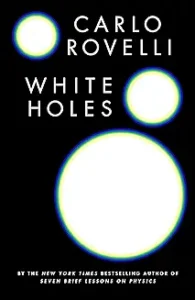White Holes by Carlo Rovelli 2023
Rovelli is an Italian astrophysicist who has written several books that seek to explain the complex science of Einstein’s relativity and quantum mechanics to the general reader. He by and large succeeds in this endeavor because he is brilliant at finding metaphors for these inherently irrational and unreal concepts, using illustrations and plain language to describe how light can simultaneously be a particle and a wave, how time is a theoretical concept that can actually flow in both directions, and how space and time are a single fabric that can be distorted and even torn.
His prior books ‘Seven Brief Lessons on Physics’, ‘The Order of Time’, ‘Helgoland’, and “There are Places in the World Where Rules are Less Important than Kindness” are all worth reading and have been helpful for this aging former scientist in his quest to understand the universe in which we live. This book is no exception, as Rovelli delves into the phenomenon of Black Holes and emerges with a new concept, that of White Holes which are the dust speck sized remnants of giant stars that themselves evolved from the aggregation of hydrogen clouds under the influence of gravity.
I will admit that much of this slim volume went past me in a flash and has left little evidence of its passing. On the other hand, Rovelli writes beautifully and once again his metaphors and illustrations were very useful. The metaphor portrays the universe as two tanks of water separated by a bulkhead which can be lifted. When the level of water is the same in both tanks, there is equilibrium and it makes no difference whether the bulkhead is open or closed. When the level of water in one tank is higher, this creates a disequilibrium which is then activated by an event, the opening of the bulkhead which in turn leads to disruption, a wave, in the lower tank and the release of the energy inherent in the different levels in the two tanks. Rovelli likens our universe and its origin in the Big Bang to the singularity involved in a disequilibrium at the original moment in time. All events in the last 4.5 billion years of our universe result from that directional flow from dis- to equilibrium. That is also why time is directional and the past is different from the future.
It would make little sense for me to attempt a detailed explanation of why a black hole ends up resulting in a white hole. The explanation involves concepts like the granularity of space, the Planck star and mass, and perhaps even dark matter. But, that doesn’t detract from the beauty of this book. If you, like me, are in awe of the nighttime sky with its billions of stars, planets, exoplanets, nebulae, and unknowns and feels the same awe when I look at the human body with its tissues and cells, this is a book to savor. Rovelli draws heavily on Dante’s ‘Inferno’ quoting passages that are relevant to his science and comparing Virgil’s guiding in the upper reaches and Beatrice’s presence in the lower reaches to his own quest for knowledge and understanding. As he writes, “Science and art are about the continual reorganization or our conceptual space, of what we call meaning. What happens when we react to a work of art is not happening in the art object itself, of course—still less to some mysterious world of the spirit; it lies in the complexity of our brain, in the kaleidoscopic network of analogical relationships with which our neurons weave what we call meaning. We are involved, engaged—for this takes us out of our habitual sleepwalking, reconnecting us instead with the joy of seeing something anew in the world.”
And this is what reading Rovelli is all about. I may not be much smarter about astrophysics, but once again, I’m enriched by this reading experience and look at the world anew.



